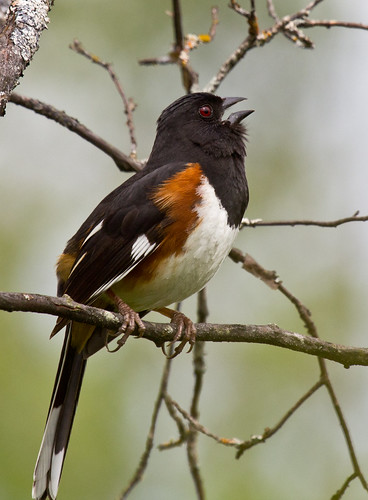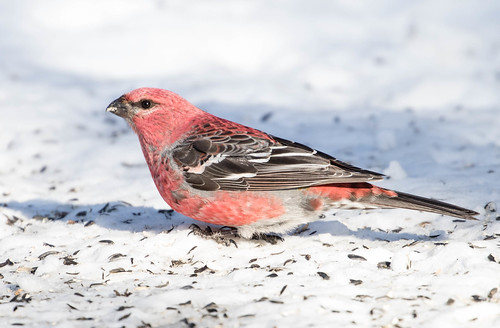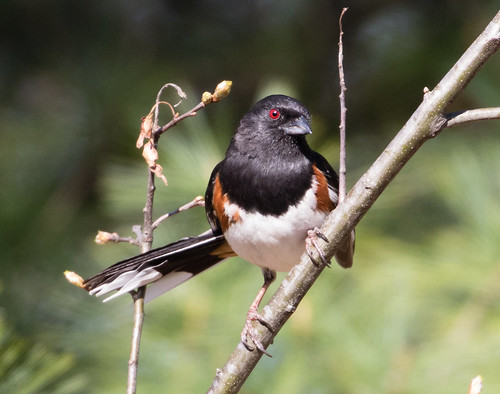When my children were little, Russ built them a sandbox in our yard. Year-round, except when snows were deep, the kids played in it—even bundled in their snowsuits, when they tired of sledding and building snow forts, they’d use their shovels and Tonka trucks to clear paths in the sandbox, pretending to be driving snowplows. In summer they pretended to be construction workers pushing those bright yellow Tonka trucks all around, or they’d build sandcastles, filling up containers of wet sand and plopping them upside down to make all kinds of interesting constructions.
My kids weren’t the only ones who spent time in that sandbox. In winter, Evening and Pine Grosbeaks and both species of crossbills spent a lot of time there, picking up grit. Back then, before digital photography, we didn’t take many photos and didn’t even have a telephoto lens, so I never made a permanent record of the charming pictures I still have in my head of brilliant crimson Pine Grosbeaks and White-winged Crossbills perched atop bright yellow Tonka trucks, but the memory makes me smile.
We didn’t get too many birds at the sandbox after the winter finches departed, except the ubiquitous Evening Grosbeaks, but over the years, on a few April and early May mornings, I spotted a bird scratching in the sand. I’d grab my binoculars, and what to my wondering eyes should appear but a Rufous-sided Towhee! The only times I ever picked them out in my yard in the 37 years we’ve lived here were in that sandbox. So I associate towhees with children, as does a listener named Gretchen.
Every year, my now 11-year-old son looks for silliness in the edge of our woods—leaves stirred to flight by a Rufous-sided Towhee. It's his favorite.Towhees are birds of forest edges, overgrown fields, and scrubby areas. Dense shrubs for hiding in and leaf litter for scratching in seem to be fairly essential. I saw my lifer towhee at a nature center outside Chicago in December 1975. I saw them regularly when we lived in East Lansing Michigan and then in Madison, Wisconsin. Range maps show Duluth on the very extreme northern edge of the Eastern Towhee’s range. The place nearest me where I can count on seeing them in spring is in northwestern Wisconsin, in the Douglas County Wildlife Area protected by Friends of the Bird Sanctuary. I find them in a few spots in Wisconsin where I look for Golden-winged Warblers and Mourning Warblers, too.
 |
| From the Cornell Lab of Ornithology's All About Birds |
Towhees have declined by close to 50 percent between 1966 and 2015 according to Breeding Bird Survey data, which give a pretty accurate picture for this species. The scrubby habitat they require is not valued by many people who don’t understand that biodiversity requires an assortment of habitats, and that some habitats that don’t necessarily appeal to urbanized human aesthetic sensibilities are still uniquely valuable. Fortunately, there are people like Gretchen’s son who appreciate towhees.
From 1957 to 1998, the name Rufous-sided Towhee was the proper name for towhees from both eastern and western North America, so it’s the name I learned when I started birding. Before 1957, the bird was called simply the Towhee, and after 1998, it was split into two species, the Spotted Towhee of the West and the Eastern Towhee in our neck of the woods. The word towhee is onomatopoeic for the bird’s call note, which is also sometimes given as chewink. The song is interpreted as Drink your tea!, but on the rare occasions that anyone has ever told me to drink my tea, they did not trill that last word.
Towhees will be back in their breeding areas within a few weeks now. I’ll be heading out where I can see and hear them again. Hearing their vocalizations or listening to them scratching at the leaf litter is guaranteed raise my spirits, whether the bird is in its natural habitat or simply playing in a children’s sandbox. I’m glad there are others who treasure this splendid bird, too.


